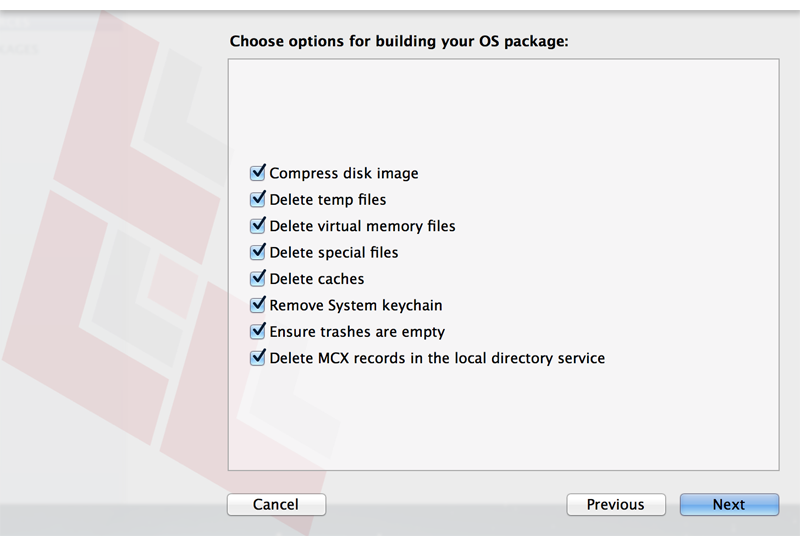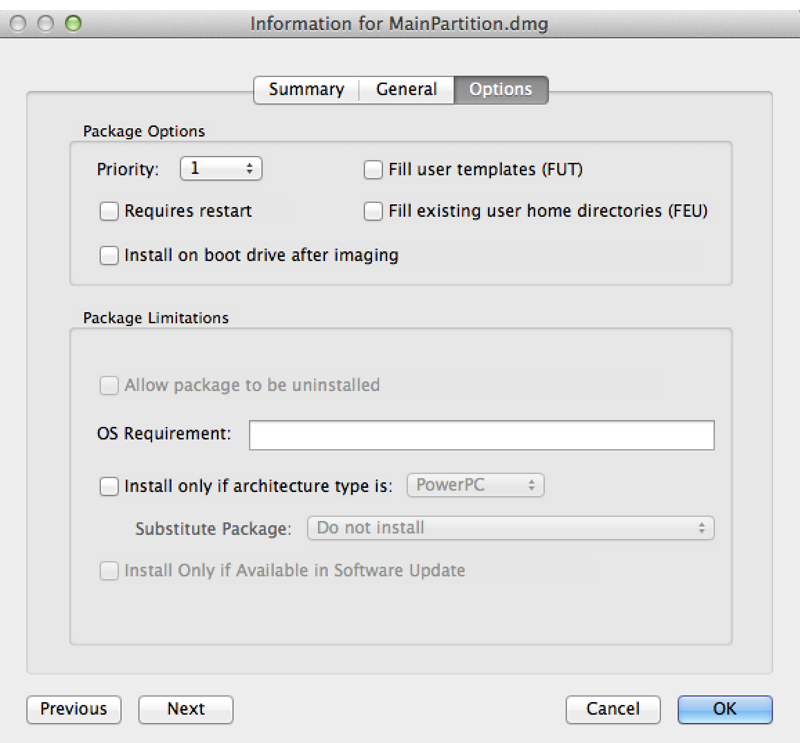Deploying macOS by Imaging
Deploying macOS by imaging involves the following steps:
-
Prepare to image a partition.
-
Image computers.
Requirements
To deploy macOS by imaging, you need:
-
Jamf Pro 9.7 or later
-
A test computer with:
-
Composer
-
A “Recovery HD” partition
-
-
Jamf Admin
-
A distribution point
-
A startup disk other than the target drive that has Jamf Imaging installed
Some common startup disks used for imaging are USB or FireWire drives, Restore partitions, and NetBoot images.
Step 1: Prepare to Image a Partition
As of macOS 10.7, newly purchased Macs come with a “Recovery HD” partition that can be used for recovery tasks, such as repairing disks or reinstalling macOS. As of Jamf Pro 9.7, you have the option to build a deployable package of an operating system, a “Recovery HD” partition, or a whole disk in a single step.
-
Build an OS package:
-
On the test computer, install and configure the OS.
For complete instructions, see the Creating a Minimal Base OS Image Knowledge Base article. -
Open Composer and authenticate locally.
-
In the toolbar, click New
 .
. -
Under the Operating System heading in the sidebar, select Build OS Package.
For information on how Composer 9.7 or later displays partitions when building OS packages, see the How Composer Displays Partitions when Building OS Packages Knowledge Base article. -
Select the drive or drives you want to package and click Next.

Important: It is recommended that the macOS version of the “Recovery HD” partition matches the
macOS version of the OS partition. -
Choose options for removing unnecessary files from the package and click Next.

-
Enter a package name and select a location to save the package, and then click Build.
-
-
Add the OS package to Jamf Admin:
-
Open Jamf Admin and authenticate to the Jamf Pro server.
-
Drag the package to the main repository in Jamf Admin.
The package is displayed in blue text until you add it to a category.
-
Double-click the package in the main repository.
-
Click the General tab and choose a category for the package.

-
Click the Options tab and choose a priority for the package.
The recommended priority is “1”.
-
Click OK.
-
-
Create a configuration:

Note: Compiling a configuration with a multi-partition DMG will result in a DMG with a single partition.
-
Open Jamf Admin and authenticate to the Jamf Pro server.
-
Click New Config
 .
. -
On the General pane, enter a display name for the configuration.

-
Click the Management tab and enter credentials for a local administrator account that you want to use for management.

-
Click OK.
The configuration is added to the list of configurations in the sidebar. -
Drag the OS package from the main repository to the configuration that you just created.
-
Step 2: Image Computers
-
On a target computer, boot to a startup disk other than the target drive.
-
Open Jamf Imaging and authenticate locally.
-
Authenticate to the Jamf Pro server when prompted.
-
Choose the drive to image from the Target Drive pop-up menu.

-
Select the Erase target drive checkbox.
-
Assign a name to the computer by entering a name in the Computer Name field.
-
From the Configuration pop-up menu, choose the configuration you created in “Step 1: Preparing to Image a Partition”.
-
Select the Boot to target drive after imaging checkbox.
-
Choose a distribution point from the Distribution Point pop-up menu.
-
Click Image.
-
Repeat as needed for other target computers.